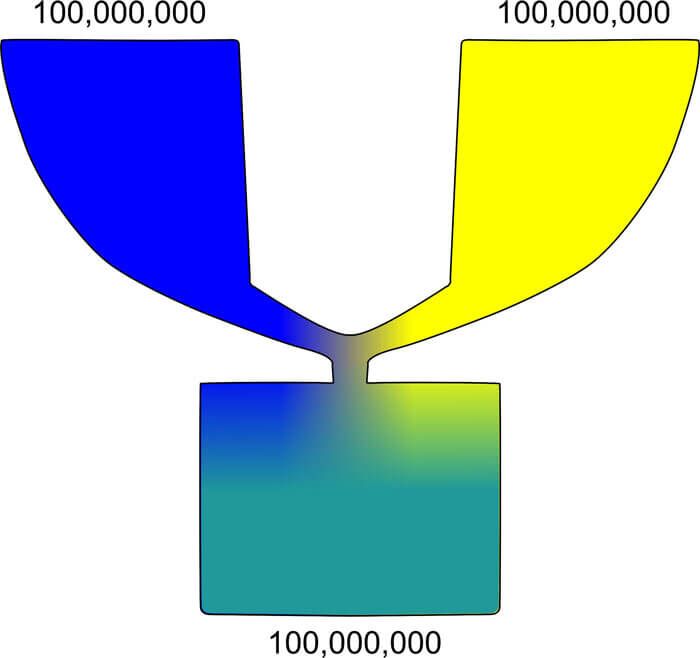Everyone knows that genetics produce results that are variable and often unpredictable. No two people, plants, or animals are exactly the same. That fact is inescapable, even for full siblings. Personally, I have one son who stands 6' 3" tall and another who is 5' 11". A few years back, I was right in the middle. Our human genetics bounce around in fascinating directions. So do genetic combinations in Texas Longhorns.
TLH - Newsletter (englisch)
Used courtesy of Dickinson Cattle Co. USA

Calculating the Mystery of Bounce
Erstellt am: von Longhorn
DCC Ranch e-News #306 - 3-09-23 (Kopie)
by Darol Dickinson

I have read that when a bull and cow are mated, each parent offers as many as 100,000,000 different DNA markers. When these determiners funnel down to form a calf, certain bits from each parent contribute to the new life. But the combinations may differ in 50 million ways for full siblings. The odds are in the mega-millions that even full siblings will look exactly alike. Some almost do, but sometimes even identical twins do not show family similar resemblances. The unpredictable results are what God decides to let flow down the mysterious genetic funnel.
I'm not a degreed professional in this science. But for more than fifty years I have raised, owned, and watched over 20,000 Texas Longhorns---some very closely. Some traits in these cattle happened over and over. Those common, recurrent variables were easy to calculate and predict. Others, however, were rare and occurred only in a tiny fraction of births.
Three scientific terms can describe exceptional new calves: mutation, outlier, and sport. As professional producers, let's use "bounce" as a common noun to include all three outcomes.
~ Mutation: the changing of the structure of a gene, resulting in a variant form that may be transmitted to subsequent generations, caused by the alteration of single base units in DNA, or the deletion, insertion, or rearrangement of larger sections of genes or chromosomes: "mutation is, ultimately, the only way in which new variation enters the species."
~ Outlier: a person or thing that is atypical within a particular group, class, or category. It can be far better or far worse than the specimen average.
~ Sport: a plant [or] animal, which exhibits abnormal variation or departure from the parent stock or type in some respect, esp. in form or colour; a spontaneous mutation; a new variety produced in this way (Oxford English Dictionary, def. 6.b).
Despite their differences, for this discussion all three terms illustrate the collective concept of a "genetic bounce."

Even though every plant in a commercial tulip field may have almost identical DNA, sometimes one blossoms differently. The newcomer is a mutation, outlier, or sport. Such genetic bounce happens rarely, suddenly, and unpredictably. It's hard to know when, which, and how a bounce will occur. It's even harder to identify, reproduce, or even evaluate a bounce. What if it embodies the most-valued trait in the field--or is worthless?
In studying the bounce in Texas Longhorns, we can examine many traits such as fertility, birth weight, rate of gain, conformation, hide and horn color, coat pattern, horn angle and twist, disposition, intelligence, and so forth. Unfortunately, these factors are sometimes subjective and always almost elusive. Considering all of these traits, other historic virtues, and their percentages would take a long time and a massive computer. Analyzing them manually would drive one over the edge.
For the practical purposes of this article--to understand bounce in Texas Longhorns it's best to begin with one convenient, factual calculation. Tip-to-tip (T2T) horn-measurement is the easiest and most objective trait for understanding data, so let's use that method to look at some important genetic bounce history.
In the early 1980's, a few cows began to stand out, including the celebrated Doherty 698 ($120,000). Her sire, Senor Mulege, a Wichita Reserve (WR) bull, carried just a hair over 40" of horn T2T. I'm told that Doherty 698 was 75" in her later years--well above her ancestors. When flushed for embryos, it was a serious and difficult decision to identify which bull to use. She was so superior to her ancestors, what sire would push her excellence forward? Because no collective data or plan was available, the shotgun approach was used, and flushed her with 11 different sires over a 24-month period.
From these flushes, Doherty 698 produced many progeny above herself and well above the breed. Two of her sons, Overwhelmer and Phenomenon, bounced above the ceiling. They were not only better than everything in their ancestry. They sired progeny well above themselves to take even larger steps in genetic improvement. Their data easily proved a successful bounce.
In sharp contrast, many of the most famous Texas Longhorn cows and bulls never produced any calves superior to themselves. Every offspring was below them in quality. They produced no upward genetic bounce.
Some of those great-but-unproductive individuals were not mated correctly. Therefore, it was nearly impossible for them to contribute an upward bounce. With the right matings, however, they could have produced genetic improvement. Here are two notable successes.
Rio Grande reached a top measurement of 80.875" T2T. He sired 14 bulls over 80", two over 90", and one cow over 100". That cow was BL Rio Catchit, one of the most profitable ever with an over 20" bounce. That is a measurable, and notable bounce of great profit to many, well over her sire and dam.
Hunts Command Respect was 77.75" and sired many over-80" and over-90" progeny. Had he not had the bounce factor, his family would have been totally unknown today.
Accurately identifying bounce takes detailed data from 50 to 100 of a bull's progeny. The bounce begins to show when cattle are retained in the same herd with year-to-year comparative analysis. Cows are harder with fewer progeny.
It's hard, however, to identify bounce and make a profit with cattle from different herds. When they are bought, sold, and relocated, their data are comingled. As a result, comparisons are not always statistically valid. Bounce could be a possible factor, but producers typically just don't watch for it. If they do, the data are invalid or lost in comingled ownerships. The bounce may be there but unobserved. Potentially prepotent bulls become steers, eliminating any future stature as sires. Undetected cows unfortunately rarely or never become the dams of champions.

The calculations in this chart came from the ArrowHead Gallery of Horns. (The raw numbers came from on line data published of registered Texas Longhorns, thank you, Craig Perez. See http://www.arrowheadcattlecompany.com/GalleryOfHorns.) Although the numbers are believed to be exact, accurate interpretation and comparison are tricky, because the data include variables such as the age of sires and their number of active breeding years. For example 11.9% of one sire's progeny measures over 80", but his oldest haven't yet come to age 5. Additionally, many great bulls are not included, and some younger bulls are showing great forward data.
This chart is a sampling of one characteristic to consider for a profitable business. With a few days of thinking and a lot of head-scratching, each breeder can identify other important traits, calculate favorite bulls and cows, and compare different combinations for possible matings. This kind of genetic planning is a tough mental exercise, but the value of the Texas Longhorn justifies a lot of serious calculation.
Let's look at some telling information in the chart. Cowboy Tuff Chex is the strongest sire in the 70"+ division, which includes 41.12% of his total progeny. A huge 27.91% of Clear Point's registered get measures 80" or more. In the 90"+ evaluation, Clear Point has 9.3%. Cowboy Tuff Chex has 2 sons over 100".
Fifty-Fifty has 4 daughters over 100". Allowance for age gives him an advantage with more years to accumulate impressive progeny.
In-herd data show that cows average 18% more T2T than bulls. Furthermore, they achieve higher data more often than bulls: in this chart, 30 cows but only 4 bulls are over 100".
Jamakizm (not on this chart) has a top measurement of 83". His bounce progeny (not including females) numbers 14 sons over himself in the 80s and 90s.
Many feel that Cowboy Tuff Chex is unquestionably the top sire in the breed for horn; however, he has not added a genetic forward bounce. His individual data are undeniably extreme, but in 12+ years he has not sired sons or daughters with horns superior to his.
A stellar example of consistent genetic bounce is the cow Field Of Pearls. Her tip-to-tip measurement at age 12 was 71.25." Her first calf at age 2 was Over Kill, who reached 80" and was a major sire of excellent type and strong black color. At age 4, she gave birth to Tempter, who was 85.25" and sired one daughter over 100". Field Of Pearls is the dam of Dragon Pearl who has again bounced up, producing 3 sons over 90" T2T and each weighing over a ton.
The term consistency is freely tossed around in Texas Longhorn chat but should be examined closely for its relevance. Is consistency the most important trait, at the top of the pile? Is it typically above average? Like hot financial stocks, what percentage of progeny are in the top data and how consistently do they remain at the top? How many different points of value consistently appear in the same family? Do they reveal themselves consistently in fertility, horn size and shape, rate of gain, stunning color, correct conformation, size, gentle disposition, intelligence---or all of the above and more? Is consistency just one virtue? If so, what is that virtue worth? At point, can the genetically superior bounce be identified and perpetuated consistently?
Genetic bounce is the chief, and fastest factor that has improved Texas Longhorns. As we have seen in one valuable trait, in only 50 years it has helped increase the rate of horn measurement from 20" tip-to-tip to well over 100". We have been rewarded with surprising forward progress by identifying bounce genetics like this in different families and then banding those families.
If producers continue to objectively identify those "bounce" families and mate them carefully, their diverse new genetic factors will amaze us all. The resulting cows and bulls and steers will continue to blow the roof off!
*Special thanks to David A. Richardson, Kirk Dickinson, Craig Perez, TLBAA, ITLA, Hired Hand and other data sources.
Dickinson Cattle Co., Inc.; 35000 Muskrat Rd.; Barnesville, OH 43713; 740 758-5050
